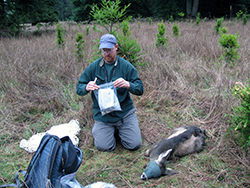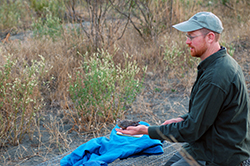Dave Lancaster is an environmental scientist covering Humboldt and Del Norte counties for the Northern Region’s Wildlife Management Program. He has been a unit wildlife biologist for the past 13 years, covering a variety of issues involving birds and mammals including hunting program management, human-wildlife conflict, wildlife disease and welfare, habitat restoration, special-status species protection, population monitoring, research and providing technical assistance to other CDFW programs, agencies and the public.


Dave Lancaster is an environmental scientist covering Humboldt and Del Norte counties for the Northern Region’s Wildlife Management Program. He has been a unit wildlife biologist for the past 13 years, covering a variety of issues involving birds and mammals including hunting program management, human-wildlife conflict, wildlife disease and welfare, habitat restoration, special-status species protection, population monitoring, research and providing technical assistance to other CDFW programs, agencies and the public.
Dave grew up in eastern Oregon and graduated from Oregon State University, earning Bachelor of Science degrees in both Wildlife Science and Fisheries Science. He has worked as a biologist for more than 20 years, the last 17 of which have been with CDFW.
What led you into a career as a wildlife biologist?
Hunting is a part of life out in rural eastern Oregon, and you start young. This early introduction to game quickly grew into a much wider appreciation for the land and wildlife in general. While there are a number of different jobs that allow a person to satisfy their desire to work out on the land, being a wildlife biologist provides an opportunity to work for the benefit of wildlife and the people who appreciate it.
It is interesting that you have degrees in both Wildlife Science and Fisheries Science. How did that come about?
I wanted to have a career in wildlife management, but most of the work was in fisheries, so I was hedging my bets.
What brought you to CDFW? What inspires you to stay?
Early in one’s career as a biologist, it is often necessary to be flexible and willing to go where job opportunities take you. Like many people in other states, my image of California was crowded freeways and urban sprawl. I never imagined I would make a career here, but when a job came up, I took it, figuring I would not be here long. It was a nice discovery for me that California still has a wealth of wildlife and wildlands, and diverse opportunity to work toward making a material contribution to conservation.
What is a typical day like for you at work?
Unit wildlife biologists have such a wide variety of duties that we typically work on several distinctly different issues in a day, and frequently have our plans changed by new developments occurring in any one of the many tasks we cover. I may on a given morning start to design a study, do a survey or prepare a management plan. Then the phone rings and I am being told a bear broke into a chicken coop, a deer is tangled up in barbed wire or a group of birds has been found dead on the beach – and the day just changed.
What is the most rewarding project that you’ve worked on for CDFW?
There are so many rewarding moments in a biologist’s career, it is difficult to pick out one particular thing. There are those projects that are not enjoyable to work on in the moment, but are very rewarding in the end because of the benefit to wildlife they produce. For example, developing habitat improvement projects and mitigation for impacts from development projects involve a lot of time at the desk, in meetings and conferring with folks with differing opinions and goals. Then there are the days when you are out in woods, grasslands or marshes doing surveys or tagging wildlife. You also get personal satisfaction and thanks from the public for helping a particular animal in some form of distress, such as when a deer or an elk is tangled up in barbed wire and you are able to free it up and send it on its way. On other days, you get the opportunity to help a person who is having some type of problem with wildlife. Of course, for wildlife biologists, any day improving the outlook for wildlife constitutes a good day, but if doing so happens to involve watching, handling or tracking animals, then all the better.
What is your favorite species to interact with or study?
The groups of species that I interact with most frequently are game birds and mammals, typically through managing hunting programs, helping landowners who are having conflicts with wildlife and responding to disease outbreaks. I do not have one particular favorite species. It is a diverse and fascinating world out there, with each one having its own appeal.
If you had free reign and unlimited funding, what scientific project would you most like to do?
Figuring out how to restore and maintain native grassland habitats while accommodating commercial livestock ranching in the shrub steppe of the Great Basin and in coastal montane prairies would be high on the list in terms of landscape-scale conservation priorities. These areas provide important wildlife habitat but the livestock industry is important as well to these rural communities. Providing for both is the key to success in the big picture.
What is it about the work you do that you would most like us to know?
Unit wildlife biologists, as with staff from most of CDFW’s programs, work every day to find practical, effective solutions to complex problems, and try when doing so to satisfy a diverse range of constituents. We have to be practical because the decisions we make and the work we do often directly affects both our constituency and conservation actions carried out on the ground. We have to come up with solutions that actually work, not just in theory; they must work for wildlife, be compatible with landowners’ desired use of their property and be implemented in a cost effective manner. Take hunting as an example: you need to provide for the ecological integrity of the wildlife population being hunted and the habitats and other species that interact with it, and provide for use by the public both in the form of hunting and viewing opportunity, and use hunting as a tool to minimize property damage the hunted species may be causing on private property.
Any advice for people considering careers in science or natural resources?
Get out in the field and read all the quality scientific literature you have time for. The university and on-the-job training are key components to building knowledge and competency, but a lifelong habit of self-education is indispensable. A broad familiarity with the collective knowledge compiled by those that came before us, tempered with extensive and considered first-hand observations from the field, are what make a good biologist.